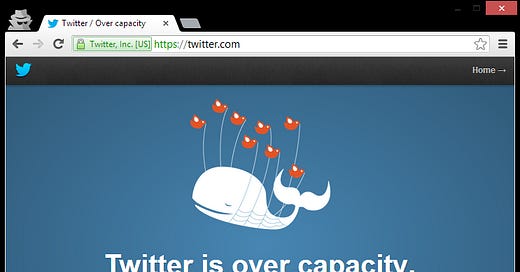Scaling Twitter: How Addressing Technical Debt Rescued the Platform
Learn how technical debt can sink companies and discover strategies to identify, prioritize, and tackle debt for building resilient systems and sustainable growth.
In the early 2010s, Twitter became viral for real time news, and they acquired a lot more customers. The company was succeeding in the social media scene and became the talk in the tech scene. But Twitter was battling a silent threat: technical debt.
In this article we will explore Twitter’s “Fail Whale” and how technical debt can cripple even the most promising companies. We will discuss how to identify, prioritize, and tackle technical debt before it spirals out of control.
Origins of Technical Debt
We often take shortcuts to meet the demanding timelines, creating technical debt. Like financial debt, it accumulates interest over time. Growing from what started as a quick fix into a bigger issue if not addressed.
“Shipping first time code is like going into debt. A little debt speeds development so long as it is paid back promptly with a rewrite or refactor. The danger comes when debt is allowed to accumulate and is not paid back.”
- Ward Cunningham, The person who coined the term
In Twitter’s case, this debt was the result of rapid feature development, shortcuts taken to meet user demands, and an architecture that couldn’t keep up with the platform’s growth.
The Rise of the Fail Whale
In its early days, Twitter’s system couldn’t handle the unexpected, rapid growth. This led to frequent outages and made feature additions and bug fixes slow and risky, while engineers were stuck in a firefighting mode, focused on maintaining stability rather than improving the platform. Twitter accumulated a lot of interest which created a culture dominated by technical debt, and damaged morale.
The Cost of Ignoring Technical Debt
Technical debt is often looked at as a technical issue and dealing with it can be doomed as an unaffordable luxury but it’s a risk that could break the business. For Twitter, the Fail Whale wasn’t just an inconvenience; it was a brand problem.
User Frustration: users began to lose trust in the platform. Frustrated by the unreliable service, some stopped using Twitter altogether.
Reputational Damage: The Fail Whale started as a fun mascot, but it soon became a public reminder of the platform’s technical struggles.
Slower Innovation: With engineers tied up in maintaining the system, features took longer to ship
As the Fail Whale became a clear threat to Twitter’s future, leadership realized the importance of addressing technical debt.
How to Deal with Technical Debt: Lessons Learned
Twitter’s experience offers key lessons for managing technical debt. Below are practical steps your team can adopt:
1. Identifying Technical Debt
Codebase Reviews: Regularly audit your codebase to identify areas of complexity or fragile components.
Tracking Debt: Use static analysis tools to track cyclomatic complexity and duplication.
Continuous Monitoring: Use monitoring tools like Datadog or New Relic to track Mean Time to Recovery.
2. Prioritizing Debt Payoff
Risk Assessment: Prioritize debt based on its potential impact on system performance and team productivity.
Debt Register: Maintain a backlog of debt items and prioritize by severity and business needs. I have a monthly MOB session with the team to pair on these.
Low-Hanging Fruit: Tackle small, high-impact issues that can be quickly resolved to build momentum.
3. Incorporating Debt Management into Workflow
Debt Allocation in Sprints: Dedicate a percentage (e.g., 10%) of each sprint to refactoring or resolving debt.
Continuous Refactoring Policy: Clean up code whenever modifying functionality to prevent future debt.
4. Long-Term Prevention Strategies
Code Reviews: Implement thorough reviews to catch shortcuts and promote the refactoring policy.
Architectural Planning: Regularly revisit architectural decisions to ensure it aligns with evolving business needs.
5. Communication and Stakeholder Alignment
Cost-Benefit Analysis: Quantify the trade-offs between addressing debt and delivering features to align with business priorities.
Narrative Framing: Use stories like the Fail Whale to convey the impact of unchecked debt to non-technical stakeholders.
Advocate for Budget: Build a business case for dedicated resources to manage and reduce technical debt.
The Outcome: From Fail Whale to Resilience
technical debt can’t be prevented. But with the right strategies, it can be paid off. I have always considered twitter journey as a reminder of the impact technical debt has on a business. Make sure to consistently pay off technical debt to streamline shipping and avoid fixing.
Support me by subscribing here and following me on X




